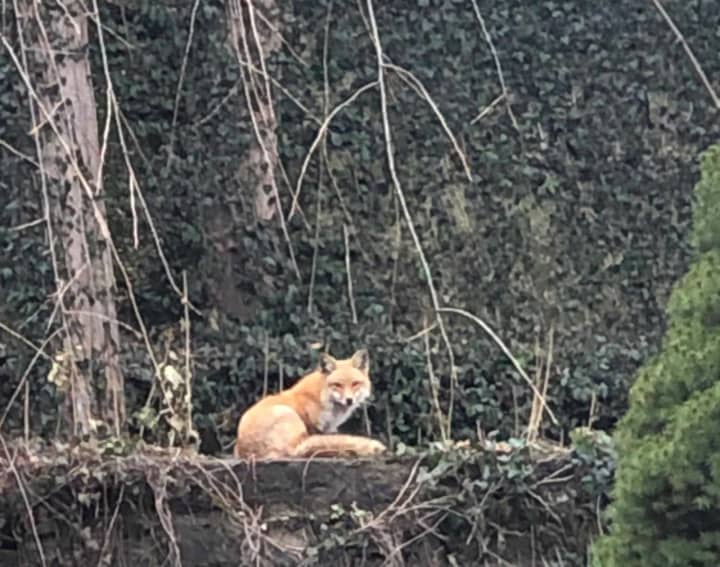What do you think the animal pictured here is?
- Coyote
- Fox
- Wolf
- Coywolf
The Tuckahoe Police Department issued an alert late last week, when what was described as "a large coyote or fox" was spotted in several backyards on Dante Avenue and Bella Vista Street, causing concern for some local residents.
The photos and caption caused a stir amongst area residents, most of whom are confident that the animal is indeed a fox, not a coyote.
"Why is that a question," local resident Elise Hunter posted on Facebook. "Of course that's a fox! A beautiful fox too!"
Another Westchester resident, Jordan Tucker added, "You would think that people in this area would recognize a lovely little fox when they see one. We see them all the time. And we see coyote too. And, we feel lucky to have them both as 'neighbors.'"
"Oh COME ON...You can't tell a fox from a coyote? It's a fox. ... A wonderful creature to behold," Bonnie C Bach posted online. "Count yourself lucky to see him. He won't attack you. (I have a fox that comes to my property. ... I love to see him bounce and play.)"
Another local resident Andy Bradford chimed in, noting, "That is a fox. They are out there. So are coyotes. This is not (a mystery). If you want to move to the burbs, then you better get used to seeing wildlife, because it exists here. There are also deer, bear, bobcat, squirrels, snakes, owls, hawks, etc. Your little yappy snack pooches are considered tasty to wildlife. So too are your cats. This is (a) reality. If you do not wish to co-exist in their habitat, then go back to (New York City)."
The Humane Society of the United States notes that foxes “have a natural fear of people. If you see one outside during the day, it's no cause for alarm. They will usually run away from you as soon as they detect your presence.”
Officials made note that:
- Foxes are not dangerous to humans, except when they are rabid (which is very rare) or when they are captured and handled. Even then, a fox’s natural tendency is to flee rather than fight;
- Foxes may prey on small pets or livestock (such as rabbits, guinea pigs or chickens), so pets should be kept indoors or housed in sturdy structures;
- Foxes will also eat various fruits, but they usually do not bother garden vegetables;
- Sometimes foxes are blamed for damage they did not cause, such as when they are spotted eating from spilled trash when neighborhood dogs or other animals were responsible for the overturned trashcan;
- A fox cutting through your yard is probably just passing through on their way between hunting areas and no action is necessary on your part.
- A complete list of advice from the Humane Society regarding foxes in the area and how to deal with them can be found here.
According to police, “as long as these animals seem to be co-existing peacefully, without signs of aggression or disease, we will typically leave them alone and encourage residents to educate themselves about the habits of these animals and precautions that may be taken.”
The DEC has outlined a series of tips to reduce the risk of having a potential coyote incident:
- Do not feed coyotes and discourage others from doing so;
- Unintentional food sources attract coyotes and other wildlife and increase risks to people and pets;
- Do not feed pets outside;
- Make any garbage inaccessible to coyotes and other animals;
- Fence or enclose compost piles so they are not accessible to coyotes;
- Eliminate availability of bird seed. Concentrations of birds and rodents that come to feeders can attract coyotes. If you see a coyote near your bird feeder, clean up waste seed and spillage to remove the attractant;
- Do not allow coyotes to approach people or pets;
- Teach children to appreciate coyotes from a distance;
- If you see a coyote, be aggressive in your behavior - stand tall and hold arms out to look large. If a coyote lingers for too long, then make loud noises, wave your arms, and throw sticks and stones;
- Do not allow pets to run free. Supervise all outdoor pets to keep them safe from coyotes and other wildlife, especially at sunset and at night. Small dogs and cats are especially vulnerable to coyotes;
- Fenced yards may deter coyotes. The fence should be tight to the ground, preferably extending six inches below ground level and taller than four feet;
- Remove brush and tall grass from around your home to reduce protective cover for coyotes. Coyotes are typically secretive and like areas where they can hide;
- Contact your local police department and DEC regional office for assistance if you notice that coyotes are exhibiting "bold" behaviors and have little or no fear of people. Seeing a coyote occasionally throughout the year is not evidence of bold behavior, and;
- Ask your neighbors to follow these same steps.
What do you think? Fox or coyote? Vote in the poll and keep the conversation going.
Click here to follow Daily Voice Port Chester and receive free news updates.



